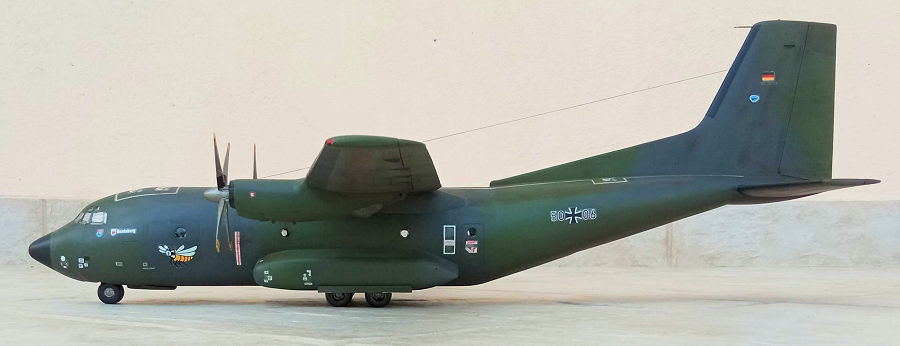
| KIT #: | 80387 |
| PRICE: | Around $35 in 2007 |
| DECALS: | Two options |
| REVIEWER: | Spiros Pendedekas |
| NOTES: |

| HISTORY |
The C-160 is a military transport aircraft, produced by TRANSALL (TRANSporter ALLianz) manufacturing consortium, comprising the companies of MBB, Aerospatiale and VFW-Fokker. The project arose from a late 1950’s requirement of both France and Germany to replace the piston-engined Nord Noratlas transports operated by their air forces.
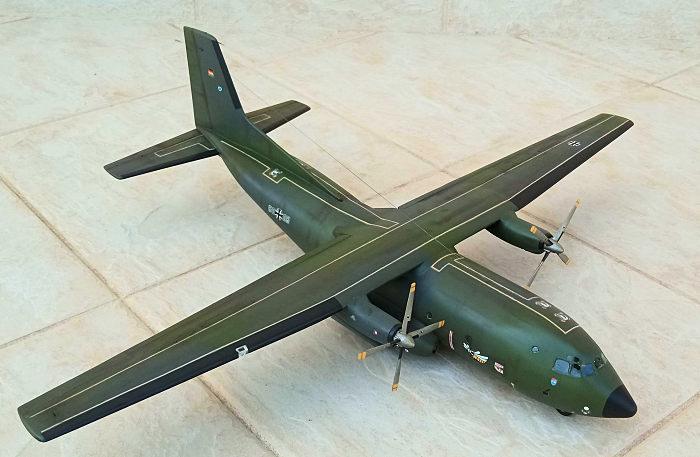 The type is
a twin-engine design, featuring a cargo hold, a rear-access ramp beneath an
upswept tail, and a high-mounted wing, able to perform cargo/troop duties and
aerial delivery of supplies and equipment. It has short airfield performance,
including the ability to perform steep descents of up to 20 degrees and perform
landings on airstrips as short as 400 meters.
The type is
a twin-engine design, featuring a cargo hold, a rear-access ramp beneath an
upswept tail, and a high-mounted wing, able to perform cargo/troop duties and
aerial delivery of supplies and equipment. It has short airfield performance,
including the ability to perform steep descents of up to 20 degrees and perform
landings on airstrips as short as 400 meters.
Later production C-160s could carry up to 8.5 tons across a distance of 5,000 kilometers, taking off from airstrips as short as 700 meters. Depending upon aircraft configuration, a single aircraft could airdrop as many as 88 paratroopers or transport up to 93 equipped troops. A very useful feature is that the whole plane can be lowered while on the ground through partial retraction of its landing gear, making it easier to move vehicles into the hold as they don't need to climb a ramp.
As of 2022, the C-160 still remains in service, almost 60 years after the type's first flight in 1963. An ample performer, it has provided logistical support to overseas operations and has served in specialist roles such as an aerial refueling tanker, electronic intelligence gathering, and as a communications platform.
With 214 built, including export sales to South Africa and Turkey, as well as to a small number to civilian operators, this well designed, dependable aircraft is going to be replaced in French and German service by the Airbus A400M Atlas and a small number of Lockheed-Martin C-130J Super Hercules operated in a multinational unit.
| THE KIT |
Heller introduced this kit in 1984, regularly reboxing it ever since, with additional parts or decals, in order to cater for different versions. The initial release additionally featured three vehicles and a number of Comandos, but seemingly those were omitted in later reboxings. My specific version was the 1995 rebox, coming in the usual big and sturdy Heller top opening box, with a nice box art of an Armée de l'Air C-160G “Gabriel'' electronic reconnaissance plane.
Upon opening the box, I was greeted with not more than 71 styrene parts. The two
fuselage halves are separately provided, whereas the rest of the parts are
arranged in 5 sprues, with one of them being exclusive for the “Gabriel”
version. The sprue containing the props is done in silver-gray, the dedicated
for the "Gabriel" version sprue in w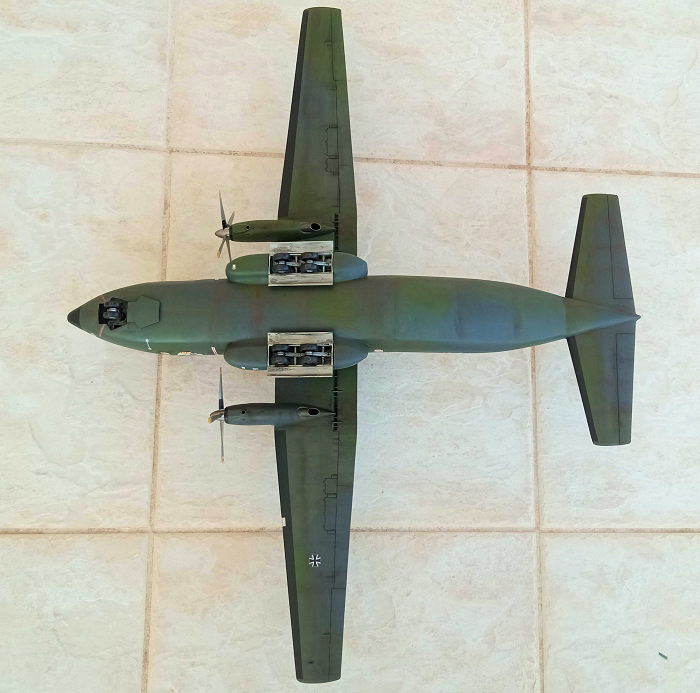 hite,
with the rest in an olive green styrene. Molding is not bad, with some flash
that will have to be cleaned off. Panel lines are raised all over.
hite,
with the rest in an olive green styrene. Molding is not bad, with some flash
that will have to be cleaned off. Panel lines are raised all over.
Cockpit is very sparse, featuring only a floor (extending to the back to double
as cargo area floor) with simplistic molded on crew seats, a plain bulkhead and
a crude pilot to place in with no other interior detail provided. Landing gear
not only is equally simplistically replicated (including nonexistent bay
details), but also the wheels’ inner faces are hollow, resulting in unrealistic,
toy-ish looks. Clearly, cockpit, cargo area and landing gear renditions are not
among the kit’s strong points, with the Out Of the Box (OOB) builder’s hopes
leaning to the above less than perfect areas being invisible or, at least,
partially hidden upon completion.
The fact that the rear ramp and crew entry door are separately given, means
that, if you go for the “open” option, you will have to somehow detail the plain
interior. The engine nacelles, which are molded together with the wing halves,
are passable, with molded-on exhausts. Props look good. Finally, the
dedicated sprue for the electronic warfare “Gabriel”, containing various
electronic extras and a multitude of small antennas is sufficiently appointed
with, thankfully, not that much flash.
Clear parts are reasonably done, but thick (not necessarily a bad thing in this
case, due to the interior sparseness...). Instructions are typical old style
Heller, coming as an 8-page A4 booklet, containing a short history, with the
construction spread in 12 clear steps. Two marking options are provided, for a
French "Escadre Électronique Tactique" electronic warfare machine in dark
green/dark gray over light gray and one for a German Luft Transport example.
Colors are only given in Humbrol codes, meaning that, unless you are a Humbrol
aficionado, having your conversion charts handy! Decals were tad off registered
but otherwise acceptable, looking usable despite their age.
Having a soft spot for the Luftwaffe wraparound camo and also liking the cleaner
lines of the transport version (compared with the multi-antenna protrusions of
the meaner “Gabriel”) it did not take too long to decide going for the German
Lufttransport C-160!
| CONSTRUCTION |
I started by joining the fuselage halves, with the
one piece floor, cockpit rear bulkhead and rear ramp support trapped in between.
Neither the one piece cockpit glazing nor the side windows were attached, since
I decided to replicate them with clearfix at later stages. Cockpit basic color
was Hu140 medium gray with a darker gray for the seat cushions. Since the
spartan cockpit is almost invisible, I did not bother to extra detail it, with
the same being true for the cargo interior, which was furthermore left unpainted
since what you see through the tiny windows is total darkness.
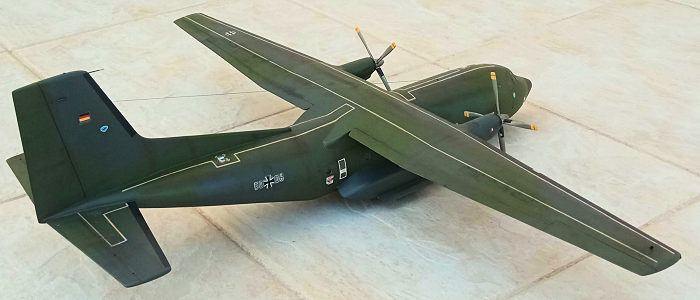 I proceeded
by attaching the rear ramp in “closed” position, followed by the belly fuselage
part. The main wheel housings were then inserted into position and “secured”
with glue. The main wing was a five piece affair that contained the engine
nacelles: it was assembled and attached onto the fuselage, followed by the
2-piece horizontal stabilizer. The nose was finally attached with a hefty amount
of lead weight trapped-in, concluding the straightforward basic assembly.
I proceeded
by attaching the rear ramp in “closed” position, followed by the belly fuselage
part. The main wheel housings were then inserted into position and “secured”
with glue. The main wing was a five piece affair that contained the engine
nacelles: it was assembled and attached onto the fuselage, followed by the
2-piece horizontal stabilizer. The nose was finally attached with a hefty amount
of lead weight trapped-in, concluding the straightforward basic assembly.
Overall fit, while not “Tamiya”, was more or less good all around, with the
occasional gaps and mismatches here and there but nothing really too serious.
After a filling and sanding session, I took the big bird to the paint shop!
| COLORS & MARKINGS |
The very nice three tone wraparound camo was
freehanded using Hu32, Hu116 and Hu117 for the dark gray, dark green and light g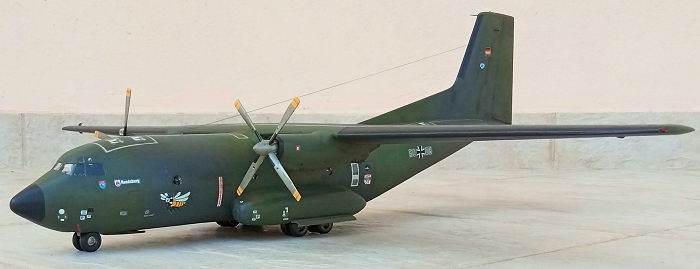 reen
respectively. The nose and deicer boot areas were masked and hand brushed with
Hu33 black, with a coat of Future preparing the bird for decaling.
reen
respectively. The nose and deicer boot areas were masked and hand brushed with
Hu33 black, with a coat of Future preparing the bird for decaling.
I used the kit decals, in order to represent the "50+06" machine belonging to
Luft Transport Geschwader 63, as it stood in Hohn in 1994. The specific machine
carried the name Rendsburg, which is a beautiful German town close to the Danish
borders. Despite their age, the decals in general performed satisfactory,
presenting only some slight silvering, which might very well be operator error.
A coat of Future sealed them.
| FINAL CONSTRUCTION |
The landing gear legs were attached, followed by the 10 wheels, paying some extra attention there in order to reassure that all of them were aligned and touching the ground. After glue curing the tires’ bottoms were “weighted'' by moving the model fore and aft with all 10 wheels rubbing simultaneously onto floor laid 220 grit sandpaper, so they acquired a “weighted”, uniform look.
Landing gear legs, wells,
door innards and wheel rims were painted aluminum, whereas the tires were
painted black. Props were painted aluminum with yellow tips and black root areas
and affixed in position. The engine exhausts were painted Testors Burned Metal.
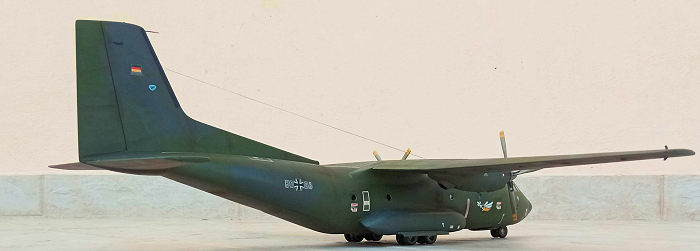 Weathering
consisted in applying some black wash at moving surfaces’ hinges and landing
gear areas, followed by application of dark brown and black dry pastels at all
places where dirt, grime or engine staining would accumulate. A satin coat gave
the bird its final finish.
Weathering
consisted in applying some black wash at moving surfaces’ hinges and landing
gear areas, followed by application of dark brown and black dry pastels at all
places where dirt, grime or engine staining would accumulate. A satin coat gave
the bird its final finish.
The front glazing was replicated by applying Clearfix with a toothpick at all
window openings, an operation that took some loops to accomplish, since Clearfix
would not always stay in place at one blow. Nothing to do with Clearfix itself,
as it is a truly wonderful stuff: it merely had to do with some openings sizes
which were way too big for this kind of application. The final result was really
great, though!
The two starboard wing blade antennas and the two fin-located VOR aerials were
attached. A small mast made from stretched sprue was attached at the top front,
followed by a thin stretched sprue aerial wire that was run from its tip to the
fin front.
The wingtip and fin top anti-collision lights were replicated with blobs of red
and green clear paints and the leading edge mounted starboard landing light
transparency was affixed in position, before calling this important military
transport done!
| CONCLUSIONS |
This is a straightforward
and uncomplicated kit of the famous Transall military transport. General shape
looks good, assembly is not too demanding with fit not posing many challenges.
On the other hand, cockpit is sparse, the cargo area is nonexistent and landing
gear is simplified with the hollowness of wheels' inner tire walls being the
(negative) icing on the cake.
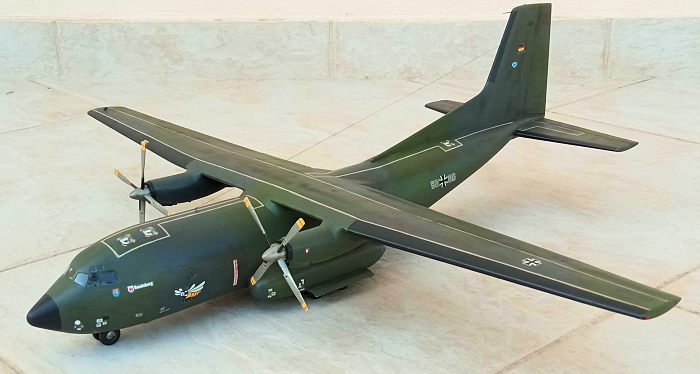 Revell came
in 2006 with a new tool C-160 which is modern in all aspects, looking really
superb and including plenty of detail in key areas. It is regularly reboxed and
offered at the usual “Revell-style” very sensible prices. Whereas it is pretty
obvious that this kit is the way to go if you want the latest and greatest 1/72
C-160, rumor has it that it is not among the easiest of builds.
Revell came
in 2006 with a new tool C-160 which is modern in all aspects, looking really
superb and including plenty of detail in key areas. It is regularly reboxed and
offered at the usual “Revell-style” very sensible prices. Whereas it is pretty
obvious that this kit is the way to go if you want the latest and greatest 1/72
C-160, rumor has it that it is not among the easiest of builds.
This leaves the now classic Heller kit in a kind of second place, offering a
simpler, easier build, but also a less detailed result. It can still be found
today (as of 2022), but not too easily, though there are chances that Heller
will reissue it at some point in the future. Out of the box, a good looking
C-160 can emerge with not too much effort, deeming this kit a good candidate for
your first 1/72 big military transport. If you own one or come across a good
offer, grab it and build it! A nice, big model of the iconic C-160 will emerge!
Happy modeling!
Spiros Pendedekas
18 November 2022
Copyright ModelingMadness.com. All rights reserved. No
reproduction in part or in whole without express permission.
If you would like your product reviewed fairly and
fairly quickly, please
contact
the editor
or see other details in the
Note to
Contributors.